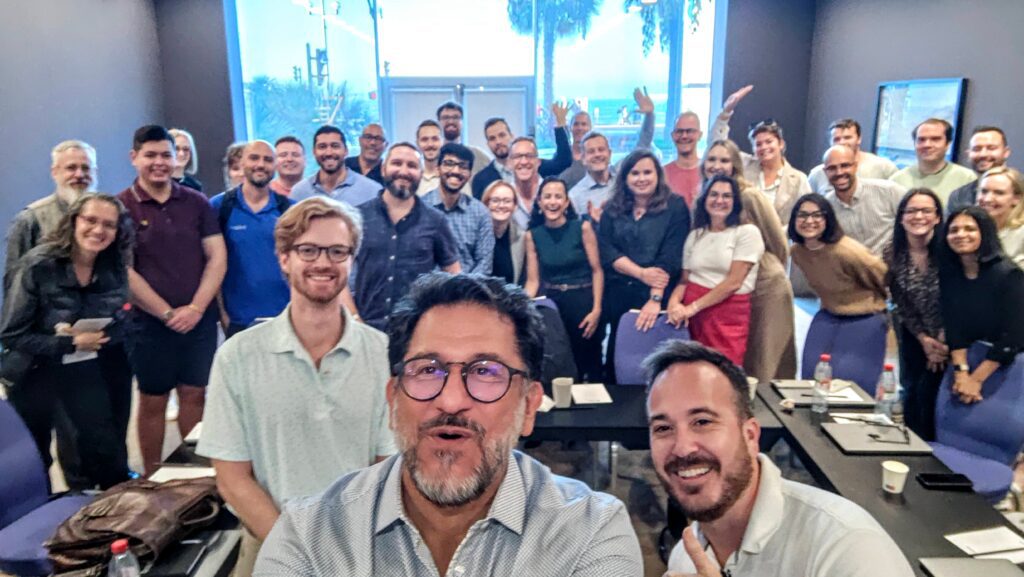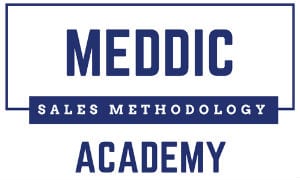MEDDIC Academy has been pioneering online courses and other digital learning experiences in Enterprise B2B sales, since 2017. These modern learning strategies are now widely used in most professional development fields, including sales training. Their appeal is evident: flexible, scalable, and often cost-effective. However, the nuances of sales—a fundamentally interpersonal field—demand more than what self-paced or automated training environments can offer. This article explores why mastering sales skills requires more, advocating for a blended approach that integrates components of live interactive training methods.
Common Learning Options in 2024
Sales professionals have access to a diverse array of learning media and methods, enabling them, more or less efficiently, to enhance their skills:
- Reading a Book (such as Always Be Qualifying): Read at your pace to delve into sales theories and methodologies.
- Online Courses, sometimes referred to as a Masterclass: Watch videos, read slides, and take quizzes.
- AI Chat with a Virtual Coach: Real-time coaching and sometimes hallucinations.
- Sales Enablement Platform: Docs, Audio, and Videos designed to support sales activities.
- Live Virtual Workshop, aka Virtual Instructor-Led Training or VILT: Participate in interactive sessions remotely for convenience and flexibility.
- Live In-Person Workshop: Benefit from hands-on practice and direct feedback in a group setting.
- Opportunity Review Sessions: Analyze and learn from real sales opportunities in a collaborative environment.
These options, offered at MEDDIC Academy, reflect the modern sales professional’s toolkit and provide various ways to master sales.
Online Courses vs. Blended Learning is like Theoretical vs. Practical Learning
Imagine attempting to learn to drive solely by watching videos, taking quizzes, and receiving automated advice from a chatbot. You might learn the rules of the road, the general functions of some car controls, and the best practices for safe driving. However, without sitting behind the wheel, feeling the car’s responses, and navigating through traffic, you would lack the essential skills needed for actual driving. Moreover, you need to know the specific car controls for your car before becoming a safe driver. Similarly, sales professionals can learn theories and strategies through eLearning or interactive tools, but the nuanced skills developed through direct customer interactions require customization of the theory to their products and services, application to their own opportunities, and live coaching from a senior sales leader.
The Essential Human Element in Sales
Sales is inherently a social profession that revolves around building relationships, understanding customer emotions, and reacting to verbal and non-verbal cues. These elements are difficult to capture fully in an eLearning or automated environment. While online courses can teach theoretical knowledge and offer simulations, they cannot replicate the unpredictable dynamics of face-to-face interactions. Real-time human interaction teaches adaptability—a key sales skill—that is challenging to develop purely digitally.
Interpersonal Skills Development
Critical sales skills such as empathy, active listening, and persuasion are honed through practice and real-time feedback. In traditional settings, a mentor or coach can respond immediately to a trainee’s pitch, body language, and sales tactics, allowing for nuanced adjustments specific to personal interaction. These subtleties are often lost in eLearning platforms, where feedback can be delayed or overly generalized.
Contextual Learning and Adaptation
Sales scenarios vary widely by industry, company, and even by customer. Effective sales training must reflect this diversity and adapt to specific contexts. Live training sessions, with customized exercises with peers or mentors, allow sales professionals to navigate complex, multi-faceted scenarios that closely mimic real-life situations.
The Role of Customization
Each salesperson has unique strengths and weaknesses, and customization is key in training. eLearning often follows a one-size-fits-all curriculum, which might not address individual learning needs or adapt to the seller’s product or service. In contrast, in-person training can be tailored on-the-fly, allowing instructors to focus on areas that need improvement, ensuring that all participants can progress at their optimal pace, and customize the lessons to the company’s products and services.
Online Courses Lack Immediate Feedback Loop
Immediate and constructive feedback is crucial for learning and perfecting sales techniques. Automated methods such as eLearning or AI, although improving, typically offer limited feedback based on predetermined algorithms and cannot fully replace the insightful, detailed critiques from experienced sales leaders. These leaders can provide real-world examples, share personal experiences, and directly respond to the specific challenges faced by trainees.
Learning Through Observation
Observing experienced salespeople at work provides novices with a nuanced understanding of how sales theories are applied in practice. This type of observational learning is nearly impossible to replicate in automated environments such as AI or eLearning. Still, it is naturally done in a live session, whether virtual or in person.
Peers and Collaborative Learning
Peer interactions can enlighten insights. Live and collective training sessions facilitate collaborative learning by bringing together like-minded professionals or colleagues, fostering interactions that can lead to understanding a challenging concept or believing something. This aspect of learning is absent in sales enablement, AI or eLearning platforms, which are typically more isolative.
Blended Learning vs. Online Courses Alone
Blended learning, which combines online classes with live virtual or in-person sessions, offers significant benefits in sales training. By integrating the strengths of both digital and live learning environments, blended learning creates a more comprehensive educational experience that caters to diverse learning styles and needs.
Humans rarely learn effectively when we hear, read, or see something for the first time. Repeating the subject is crucial for learning to occur. However, presenting the same material in the same format, the same way, through the same media can be boring and ineffective. True learning enhancement occurs when the same message or lesson is delivered in varied ways through different media. This method maintains interest and strengthens the learning process by providing multiple perspectives and contexts.
Take, for example, the concept of the “priority-to-the-right” rule in driving—a fundamental right-of-way system that mandates yielding to traffic from the right at intersections. Initially, one might read about this rule in a driving manual and understand it at a basic level. However, the rule becomes clearer when demonstrated in a video, showing practical scenarios at intersections. The deepest learning occurs in real life, though, when a driver approaches an intersection, sees cars approaching from different directions, and must apply the rule to decide whether to proceed or yield. Combining reading, online courses, and live virtual or in-person practice, this layered approach ensures a comprehensive understanding of the rule, embedding it into a driver’s reflexes and decision-making processes. That’s when the learning occurs. This is why blended learning is known to be efficient.
Higher Engagement Compared to Online Courses alone
Blended learning strategies are particularly effective in keeping learners engaged. When combined with digital content like video courses and AI simulations, interactive elements such as live discussions, hands-on practice, and real-time feedback can increase engagement and improve retention rates. This mix helps learners absorb information more effectively and apply it more adeptly in real-world situations. These sample pictures from our live in-person sessions show great visual evidence of this engagement.
Flexibility and Accessibility
One of the key strengths of blended learning is the flexibility it offers. Learners can access digital resources at their own pace and convenience while still benefiting from the structured support and personal interaction of live sessions where they interact with a senior sales leader. This flexibility is especially beneficial in sales, where professionals often manage unpredictable schedules and can thus balance training with their sales responsibilities more efficiently.
Customization of Learning
Blended learning allows for greater customization of the training process. Digital tools can be used to deliver foundation courses and provide content about the theory, while face-to-face training naturally tailors the theory with the customer’s products and services. This customized approach ensures that each salesperson receives the training that is most relevant and beneficial to their development.
Cost-Effectiveness
Combining online and in-person training can be more cost-effective than traditional training alone. The trainee can learn from anywhere at their own pace, without the need to travel or even block an imposed time on their calendar, when learning the foundation course or the theory.
Consistent Yet Diverse Learning Experience
Blended learning provides a consistent learning foundation through its digital components, ensuring that all learners receive the same base level of training. On the other hand, the in-person elements introduce variability and customization, allowing trainers to dive deeper into topics as needed, based on the group’s or individual’s proficiency and needs. This combination ensures a well-rounded learning experience that adapts to both the market’s demands and the learners’ personal development goals.
In conclusion, the blended learning model holds substantial promise for enhancing sales training programs. By leveraging the benefits of both digital and traditional educational tools, organizations can create more effective, engaging, and flexible training environments that better prepare sales professionals for the challenges of the modern marketplace.
Conclusion
While eLearning, digital learning with online courses, and, generally speaking, automated learning methods have transformed the landscape of professional training, offering remarkable tools for theoretical learning and preliminary practice, they cannot fully encapsulate the efficient, interactive, and highly personalized nature of blended sales training when used alone. The development of core sales skills—particularly those involving interpersonal interactions, real-time decision-making, and adaptive strategies—still requires the depth and flexibility of live training sessions, either virtual or in person. For businesses looking to develop top-tier sales professionals, a blended approach that combines the best of both eLearning and live sessions will likely be the most effective strategy.
At MEDDIC Academy, we have pioneered blended learning, ensuring that sales teams are knowledgeable and adept at applying their skills in the real world of enterprise B2B sales, where the human element is irreplaceable.



Comments are closed.